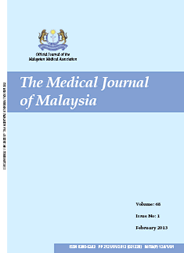MJM, Vol 70 Supplement 1 September 2015
Ending AIDS Strategy - Experience from the Thailand
Department of Disease Control (DDC), Minister of Public Health, in Thailand
ABSTRACT
Introduction: Thailand is committed to the targets of the 2011 High Level Meeting (HLM) on AIDS and has a prioritised National Strategy that pledges a two-thirds reduction in incidence in sexual transmission, and through injecting drug use (IDU), by 2016. The Thai epidemic is a very mature; at its peak in the mid-1990’s Thailand had around 160,000 new HIV infections per year. However, data consistently show high prevalence among IDU (>20%), and men who have sex with men (MSM, 8-25%) during the last 5 years. Because of the large size of the MSM population, they will contribute around 40% of new infections in the next 5 years.
Current Response: The current response characterised by peer-led behaviour change interventions for MSM, sex workers and IDU (“key populations”), and includes a range of prevention and care activities also for labour migrants, young people, and the private sector. Despite this investment, behavioural variables (condom use and needle sharing behaviour) have remained stable over several years and uptake of HIV testing and counselling is limited. At the same time, treatment initiation with ARVs is late. These factors together suggest that with the current response, Thailand will not reach the HLM targets.
Strategic Options: Thailand has the potential to be one of the first countries in Asia to ‘End AIDS’. The end of AIDS can become a reality if Thailand is able to effectively utilise the preventive effects of antiretroviral treatment. Thailand as has already shown this is possible through the virtual elimination of HIV infections from mother to child. Sustaining current positive behaviour change among key populations, making use of alternative service delivery models for HIV testing, early treatment and adherence support, adequate monitoring, quality assurance, and positioning AIDS as a chronic and treatable medical condition, are critical components to end AIDS. This new model of combination prevention needs to be focused on regions and ‘hot spots’ with the highest number of new infections to ensure better coverage and optimal use of resources. It will avert 20,000 new HIV infections and 22,000 deaths by 2022. Initial marginal cost-benefit analysis suggest that a investment of USD100 million over the next decade into HIV testing, early treatment, and adherence support can translate into potential benefits of more than USD300 million in saved hospitalisation, treatment costs, and productivity gains. The yearly additional marginal costs of around 5% of present expenditures can be further reduced by focusing financial and human resources on globally accepted high impact interventions.
Action now will pay off in the future: Every baht spent now can generate a return of three Baht. The critical action includes: scaling-up behaviour change interventions and HIV counselling and testing focusing on key populations, early treatment for people found to be HIV positive, community adherence support, and a new generation of data management and reporting.
